This step by step diy project is about 14×16 pergola plans. I think this is a pergola that comes with the perfect size, because it is large enough to create some generous shade and it is also compact making it budget friendly. In addition, I have designed this pergola to be sturdy and elegant enough to match the style of any house. The footprint of the pergola is 14’x16′, while the roof is 16’x18′. Take a look over the rest of my woodworking plans, if you want to get more building inspiration.
All my woodworking plans come with 3D diagrams and step by step instructions. In addition, the plans include full Cut and Shopping lists. Remember that you need to read the local codes before starting the project. It is your responsibility to make adjustments and suit the legal requirements.
When buying the lumber, you should select the planks with great care, making sure they are straight and without any visible flaws (cracks, knots, twists, decay). Investing in cedar or other weather resistant lumber is a good idea, as it will pay off on the long run. Use a spirit level to plumb and align the components, before inserting the galvanized screws, otherwise the project won’t have a symmetrical look. If you have all the materials and tools required for the project, you could get the job done in about a day. See all my Premium Plans HERE.
Projects made from these plans
14×16 Pergola Plans – Free DIY Guide

Building-a-14×16-pergola
Cut + Shopping Lists
- A – 4 pieces of 6×6 lumber – 8′ long POSTS
- B – 4 piece of 2×8 lumber – 18′ long SUPPORT BEAMS
- C – 13 pieces of 2×6 lumber – 16′ long SHADE ELEMENTS
- D – 4 pieces of 6×6 lumber – 46 1/2″ long, 4 pieces – 52 2/2″ long BRACES
- E – 15 pieces of 2×2 lumber – 18′ long SLATS
- 4 pieces of 6×6 lumber – 8′
- 4 pieces of 6×6 lumber – 10′
- 4 pieces of 2×8 lumber – 18′
- 13 pieces of 2×6 lumber – 16′
- 15 pieces of 1×2 lumber – 18′
- 1 5/8″ screws
- 5 1/2″ screws
- 6×6 post anchor 4 pieces
- post to beam connector 8 pieces
- rafter ties
- 8 pieces of 9″ carriage bolt
- wood filler , wood glue, stain/paint
- ties
Tools
![]() Hammer, Tape measure, Framing square, Level
Hammer, Tape measure, Framing square, Level
![]() Miter saw, Drill machinery, Screwdriver, Sander
Miter saw, Drill machinery, Screwdriver, Sander
Time
Related
14×16 Pergola – Video!
How to build a 14×16 pergola

Laying-out-the-posts-for-the-14×16-pergola
The first step of the pergola project is to layout the posts. Use batter boards and string to layout the location of the posts. Apply the 3-4-5 rule to every corner and then measure the diagonals to make sure they are perfectly equal. You need to make adjustments until you get the desired result.
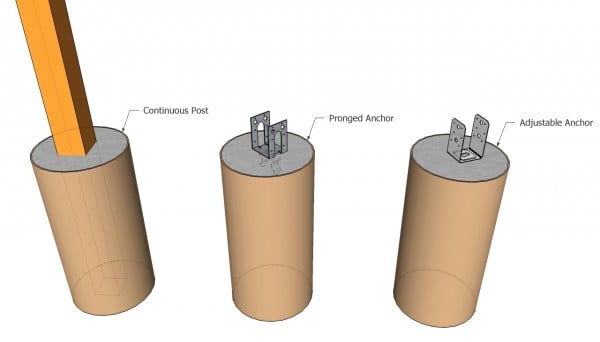
Anchoring the posts of the anchor
There are a few ways to secure the 6×6 posts into place. You can set the posts in concrete or you can use adjustable anchors and pour footings. Dig the holes 3′ deep (or under the front line) and about 12-13″ in diameter. Compact a layer of gravel to the bottom of the holes and then fit the tube forms. Fit the posts, align them and plumb them with a spirit level. Fill the forms with concrete, while the posts are locked into place with temporarily braces. If you use anchors, you need to align and set them into concrete. Fit the posts after the concrete dries, using lag screw.
Smart tip: Read the local building codes, so you dig the holes at the appropriate depth. For this project, I will assume you will use post anchors, so if you set the posts into concrete, make sure you add 3′ to the posts size.
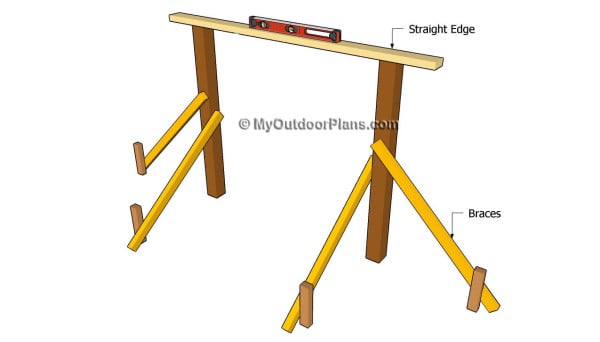
Installing the posts
Check if the posts are level and user a circular saw to make corrections. Notice the temporarily braces that hold the posts plumb.
Building the roof for the pergola
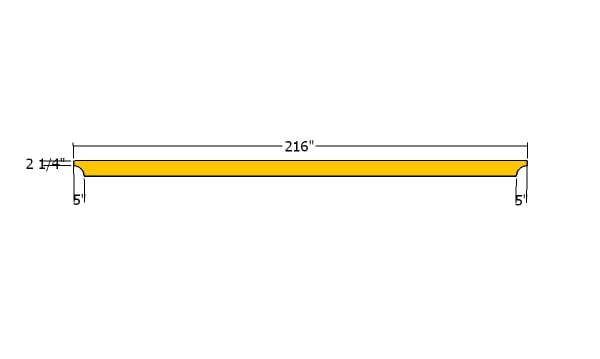
Support beams
Also, use 2×8 lumber for the support beams. Make decorative cuts to both ends of the beams. You can use a large circular item so you can draw the curved lines. Get the job done with a jigsaw and then smooth the edges for a neat result.

Fitting-the-support-beams
Next, fit the support beams to the top of the posts. Use a spirit level to plumb the support beams and then clamp the beams into place tightly. Make sure the support beams are perfectly horizontal. Drill pilot holes through the beams and through the posts. Insert the 9″ carriage bolts and then tighten the nuts.
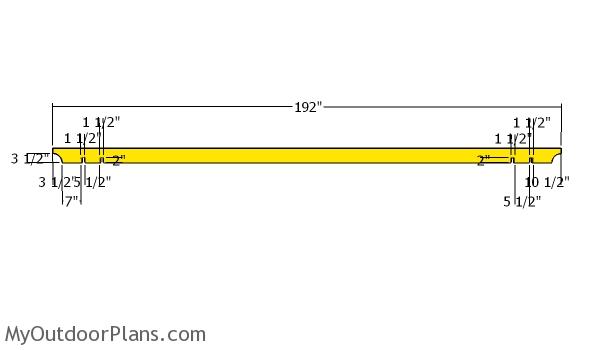
14×16 Pergola – Rafters
Furthermore, use 2×6 or 2×8 lumber for the shade elements. Make the curved decorative cuts to both ends of the beams. Mark the cut lines and then get the job done with a saw. In addition, you need to make a few 2 1/2″ deep notches, so you can fit the shade elements to the support beams.
Mark the cut lines on the beams and then use a circular saw to make parallel cuts. Use a chisel to remove the excess and then smooth the recess with sandpaper.

Fitting-the-rafters-to-the-large-pergola
Fit the shade elements to the support beams. Place the shade elements equally spaced and then lock them into place with rafter ties. Alternatively, you could drill pilot holes through the shade elements (above the notches) and insert 5 1/2″ screws so you can lock them into place tightly.
Fitting the braces
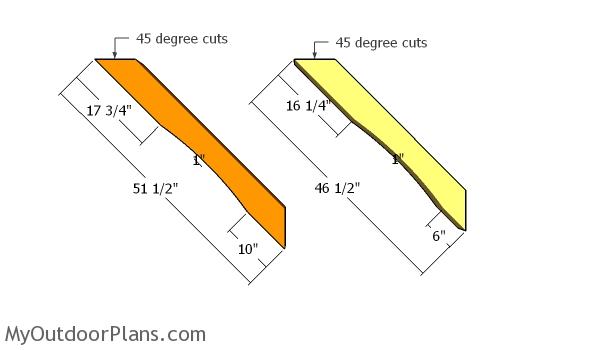
Building the braces
Additionally, use 6×6 lumber for the braces. Use a saw to make 45 degree cuts at both ends of the pieces. Also, use a jigsaw to make the curved cuts that will enhance the look of the backyard pergola.
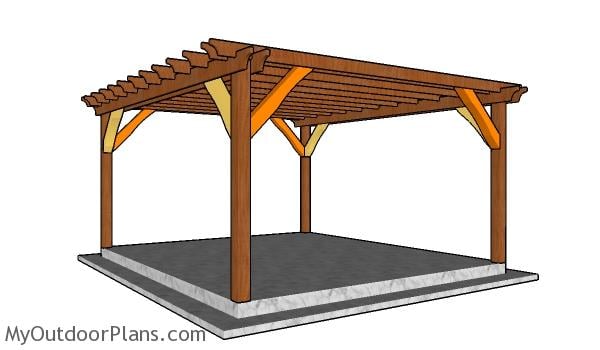
Fitting the braces to the 14×16 pergola
Next, use a spirit level to plumb the posts and then fit the braces into place, as shown in the diagram. Drill pilot holes and insert 5 1/2″ screws to secure the braces into place tightly.
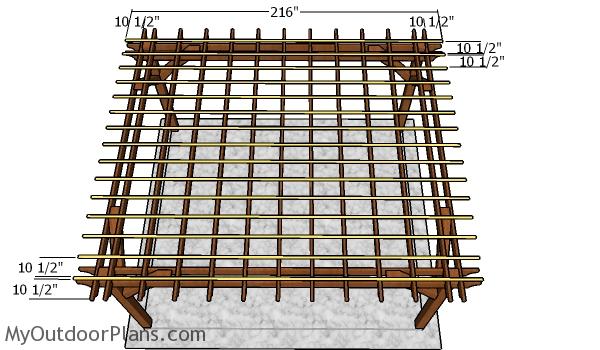
Fitting the top slats – 14×16 Pergola
Fit the 1×2 slats to the top of the pergola. Place these slats equally spaced for a professional result. Center the slats to the rafters and then drill pilot holes, before inserting the 1 5/8″ screws.
Finishing touches
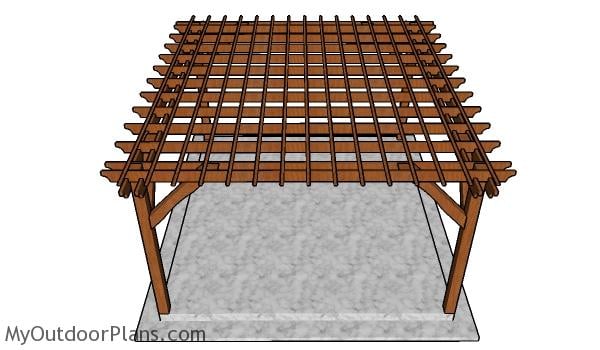
How to build a 14×16 pergola
Last but not least, you need to take care of the finishing touches. Therefore, fill the holes with wood putty and then smooth the surface with 120-220 grit sandpaper. Apply a few coats of paint or stain over the components, to enhance the look of the patio pergola and to protect the components from decay.
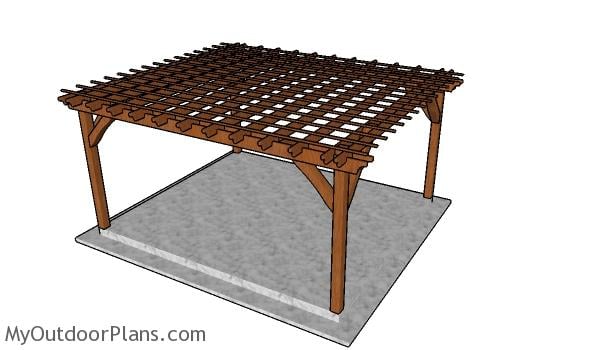
14×16 Pergola Plans Free
As you can see, building a pergola is not as difficult as you might imagine. Om the contrary, you can build it in a few days and make a beautiful and useful addition to your house with a minimal investment.

14×16 Pergola Plans Free
If you want to add charm and unique appeal to your garden, I recommend you to check out these plans. This pergola can be built by any person with basic woodworking skills and it is also very budget friendly. You can make a lot of adjustments to the design so it suits your tastes and needs. Check out the rest of my pergola plans, as I have many designs and sizes you can choose from.
This woodworking project was about 14×16 pergola plans free. If you want to see more outdoor plans, check out the rest of our step by step projects and follow the instructions to obtain a professional result.

7 comments
I am thinking of building the 14×16 pergola plan free DIY guide how ever the material list I had questions on 9” carriage bolts do 2 go in at each post on the same side ? , rafter ties do they go on the inside of the support beams, and how should I anchor the braces to the support beams I was not sure from the drawing and the video. I really like the look of the pergola if I could get some instructions that would be great thank you so much .
Yes, to first question. It would be great to fit the ties to the interior so it’s hidden, but I don’t think you have enough room to drive in the screws. You fit the braces and lock them to the post and to the support beams with screws.
So what are the dimensions of the carriage bolt = 3/8 in.-16 x 9 in. or something different?
What could i do differently if i want to double this to 28×16
You mirror the pergola and the rafters meet on the common support beams.
Instead of using 6”x6” wooden post, is it possible to use 4”x4” steel post (standard schedule 40) or I use 6”x6” steel post. Will the 4”x4” steel post can carry the total dead load of the wooden beams and joists? Also to improve wobbling effect, is it better to bury the posts 3’ below ground or I use steel anchor and lug so I don’t have to use a bracket between the posts and beams, where I can envelope the post with a round vinyl or reinforced fiberglass column in the future.
What was the rough cost of materials for this build?